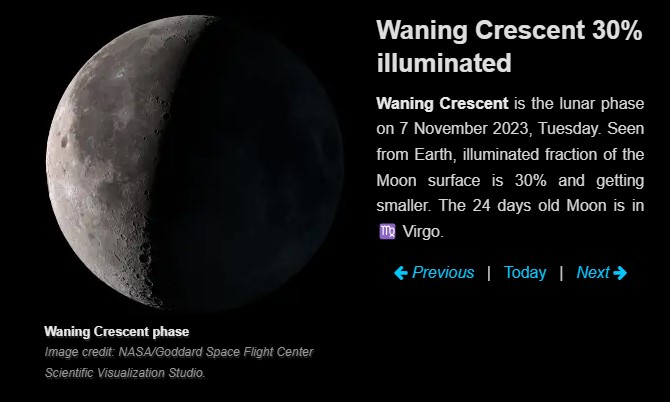Tomorrow Moon Phase November 7 2023: November 07, 2023 On November 7, 2023, the Moon will be in its Waning Crescent phase. This phase is best observed in the western sky just before sunrise. During this phase, the Moon’s illumination gradually decreases each day until it reaches the New Moon phase.
As the Moon moves closer to the Sun from Earth’s perspective, only a small portion of the Moon’s edge is illuminated, with the rest facing the Earth in darkness. This phase provides a great opportunity to observe the Moon’s surface features, as the craters and mountains cast long shadows along the illuminated crescent, making them more visible with a telescope or binoculars.
Tomorrow Moon Phase November 7 2023
To view the daily moon phases for the entire month of November 2023, please visit the November 2023 Moon Phases Calendar.
Phase Details For November 7, 2023
Phase: Waning Crescent
Illumination: 30%
Moon Age: 24.04 days
The Moon Angle: 0.49
Moon Distance: 405,420.98 km
Sun Angle: 0.54
Sun Distance: 148,234,889.19 km
Waning Crescent Phase
The Waning Crescent phase on November 7th has an illumination of 30%, indicating the percentage of the Moon’s surface that is lit by the Sun. This illumination constantly changes and can vary up to 10% each day.
On November 7th, the Moon will be 24.04 days old, representing the number of days that have passed since the last New Moon. It takes approximately 29.53 days for the Moon to complete its orbit around the Earth and go through all 8 phases of the lunar cycle.
Waning Crescent: 30% illuminated
On November 7, 2023, the Moon will be in the Waning Crescent phase with an illumination of 30%. This phase occurs on a Tuesday and marks the 24th day since the last New Moon. The Moon will be in the zodiac sign of Virgo (♍) and can be observed from Earth with less than half of its surface illuminated, gradually becoming smaller.
Moon Phase for Tuesday, November 7th, 2023
The Moon phase for November 7th, 2023 is the Waning Crescent phase. On this day, the Moon will be 23.22 days old, with an illumination of 33.89% and a tilt of -257.66°. The approximate distance between Earth and the Moon will be 404,540.13 km, and the Moon will be in the zodiac sign of Virgo.
The Waning Crescent phase is characterized by the Moon being less than 50% illuminated but not yet reaching 0% illumination, which would mark the New Moon phase. During this phase, the Moon appears to move closer to the Sun from Earth’s perspective, with the night side of the Moon facing Earth as a thin crescent that gradually diminishes.
The Waning Crescent Moon will rise around midnight, reach its highest point in the sky after sunrise, and set around noon. The best time to observe this phase is 1-2 hours before sunrise, offering a great opportunity to see the Moon’s surface features. Along the illuminated crescent, you can observe the craters and mountains casting long shadows.
The Waxing Gibbous phase, like all moon phases, lasts for just over 7 days. The actual duration may vary due to the Moon’s elliptical orbit. During the Waxing Gibbous phase, the Moon will rise in the east in the mid- to late-afternoon and will be high in the eastern sky at sunset.
Related:
Assuming clear weather conditions, the Waxing Gibbous moon will remain visible throughout most of the night, setting just before sunrise. Fun fact: The illuminated side of a waning crescent moon always faces eastwards, towards the sunrise.


Leave a Reply